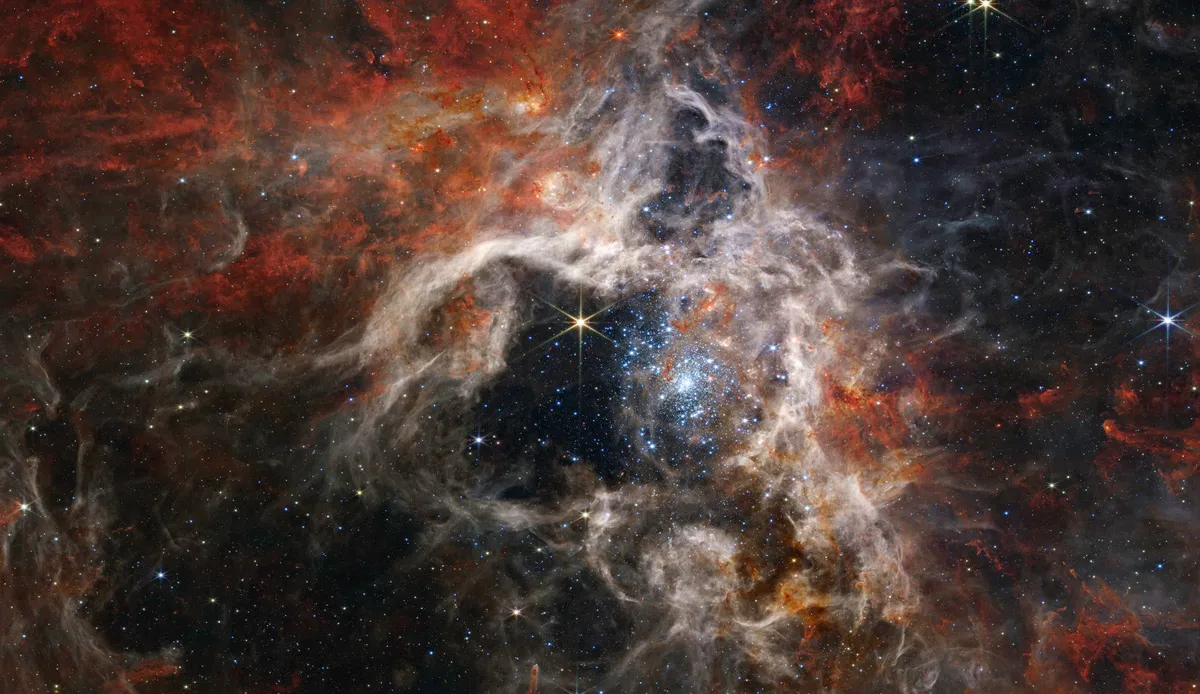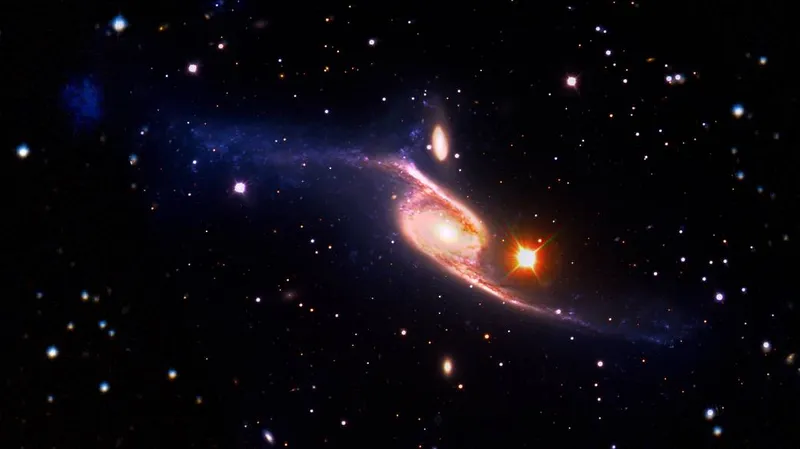Space is vast. Imagining how vast the Universe is can sometimes be mindboggling, even for some of the most modest of objects. There are some that are truly huge, but what are the biggest of the big?
It's a tall task attempting to measure distance in space or trying to determine the mass of a celestial object, but in doing so, astronomers and cosmologists have built up a picture of just how vast the Universe is.
To send us on our way here are some cosmic units of measurement that help us define distances in the Universe:
- 1 astronomical unit = 150 million km (distance from the Earth to the Sun)
- 1 Solar radius = 695,000km (distance from the edge of the Sun to its centre)
- 1 lightyear = 9 trillion km (distance light travels in a year)
Biggest planets

Thousands of potential exoplanets have been discovered in the past few years; that number currently stands at over 5,000 exoplanets.
The exoplanets largest are Jupiter-like gas giants, like HAT-P-32b in Andromeda. Its radius is around twice that of Jupiter, yet its mass is slightly lower.
“HAT-P-32b is a hot Jupiter, a type of close-in giant gaseous planet,” says Ming Zhao, a research associate in the Department of Astronomy and Astrophysics at Pennsylvania State University.
The planet only orbits at 0.034 AU from its host star, one-tenth the radius of Mercury’s.
“It experiences scorching irradiation and has a temperature of nearly 1,800ºC. This bloats its size.”
One of the largest known exoplanets in the Universe is ROXs 42Bb, which is a gas giant like Jupiter, yet 9 times the mass.
It orbits its host star 460 lightyears from Earth and is about 2.5 times as wide as Jupiter.
Biggest stars

When we up the scale a notch and look at the largest stars in the Universe, there are several contenders.
Hypergiant UY Scuti is thought to measure in at over 1,700 times the radius of the Sun, but there is a lot of variation as the star grows and shrinks over a 740-day cycle.
NML Cygni isn’t far behind at 1,642 solar radii, its enormous size caused by the 50 Earth masses of gas it loses every year creating a shroud around it, ballooning it to an enormous size. It varies over a 940-day window.

VY Canis Majoris is also one of the biggest stars in the Universe.
Whichever is truly in the lead, it is unlikely to remain there for long.
These stars are in the later stages of their lives and have at most a few million years left before they go supernova, leaving behind a glorious nebula.
Biggest nebulae

Nebulae are collections of gas and dust found throughout our Galaxy, though the largest one we know of lies beyond it, 160,000 lightyears away in the Large Magellanic Cloud.
The Tarantula Nebula is an enormous HII region 600 lightyears across. If it were to swap places with the much closer Orion Nebula it would cover the same sky area as 60 full Moons and be bright enough to cast shadows.
The nebula houses the super star cluster R136, home to some of the most massive and brightest known stars, which cause this glorious nebula.
However, when we look at the largest entrants at the next notch on the cosmic size scale, galaxies, it’s unlikely they’ll have any impressive nebulae at all.
Galaxies

The largest galaxies are ellipticals, huge collections of stars that form when two or more smaller galaxies collide and merge together, stripping out all the gas and dust in the process.
The largest known elliptical galaxy is IC 1101 in Virgo. At 5.8 million lightyears across it’s over 50 times the diameter of the Milky Way.
Made up of 100 trillion stars, it would swamp not only the Milky Way, but also encompass the Andromeda Galaxy and much of the Local Group too.
The largest spiral galaxy is currently known to be NGC 6872, which measure 522,000 lightyears across, making it over five times the size of the Milky Way galaxy.

Galaxy clusters
Though galaxies are the largest things you can look at through a telescope and recognise, there are structures that are larger still.
Galaxies clump together into galaxy clusters, and the most extreme that’s currently known is El Gordo or ‘the fat one’.
"Over the life of the Universe, galaxy clusters grow. El Gordo is from a time when the Universe was half as old as it is now, but for its time it is the most extreme," says Prof Jack Hughes from Rutgers University.
While the beast of a cluster is so large it is difficult to estimate its size, El Gordo is thought to be between 10-30 million lightyears in diameter.

"If you look at what we expect the mass of clusters to be at that distance, El Gordo is close to the limit of what we would expect to find over the whole sky: a one-off object in the Universe," says Hughes.
As it is over 8 billion lightyears away, we are looking at it as it was 8 billion years ago.
Though clusters we see in the nearby Universe are larger, after several billion years of evolution El Gordo will have grown to become a huge behemoth.
But even these galaxy clusters aren’t the biggest things in the Universe.
Superclusters

Superclusters, formed of several galaxy clusters, are the largest gravitationally bound objects that we know about, making them some of the biggest things in the Universe we've ever observed.
The Shapley supercluster is thought to be the largest at around 650 million lightyears, while the Laniakea supercluster (which contains the Milky Way and therefore us) is not far behind at 520 million lightyears.
These are the biggest things in the Universe we currently know of.
But Shapley and Laniakea are heading towards each other. Are these two becoming part of a larger structure still?

The Cosmic Web is thought to be a great network of clusters, linked with filaments of dark matter and with galaxies studded throughout.
These filaments form giant walls: the Hercules-Corona Borealis Great Wall, for example is the biggest known structure in the Universe and measures between six and 18 billion lightyears in length.
It’s so large that it’s thought to push the limits of how big something can be, breaking the cosmic size limit or the cosmological principle.
“The cosmological principle means that on very large scales the Universe looks the same in every place, and has the same density in all directions," says Peter Coles, head of the School of Mathematical and Physical Sciences at the University of Sussex.
“The problem is, what do we mean by ‘very large scales’?”

As a rough guide, the limit is placed at around 1.2 billion lightyears, but several objects have been found that are said to break this limit, such as a group of 10 gamma-ray burst galaxies that span over five billion lightyears.
But can something like this really be called a structure?
"You can have a structure that’s not very strongly gravitationally bound, like a long filament of galaxies," says Coles.
"It might be several hundred million light years long but actually the effect it has on spacetime is very small."
As vast as these structures are, some of the biggest things in the Universe may yet be undiscovered.
We can see only a tiny fraction of all there is to be seen, and no doubt even bigger monsters are lurking in the depths of our Galaxy and beyond.
How big can the biggest things be?

For all the titans we have found in our Universe, could there be a bigger monster out there
Limits on physical diameter can be hard to pin down, as mass, temperature, composition and age all play into their size. However, their masses are much more constrained.
For a planet the limit is a matter of definition: when does a big planet become a small star?
"The mass boundary between a gas giant and a brown dwarf is around 13 Jupiter masses. Below this limit an object would not be hot enough to burn deuterium, which is the point it becomes a star," says Ming Zhao.
Similarly for stars, there is a point at which their mass can become too great. Stars balance gravity crushing in and the outward pressure produced during fusion.
This balancing act is stable until around 150 solar masses in the current Universe.
But there are some stars that break this limit, such as R136a1, weighing in at 256 solar masses. Researchers are unsure how this is possible, but the current theory is that the star didn’t form this way.
Instead, two stars merged together. The bigger a star is the shorter its life, however, and before long this star will explode into a spectacular supernova.
Invisible giants

While there are some huge structures to see in the Universe, some of the biggest things in the Universe are invisible.
If you look within our Solar System, the largest object is the Sun, but its influence is felt far beyond its surface.
As well as keeping the planets in check with gravity, the Sun has a huge magnetic field, so large that the Voyager probes only reached its edge after 35 years of travelling.

On larger scales, galaxies are far greater than they appear to our eyes. It’s believed that 95% of the Milky Way is made of invisible dark matter, extending out in a great mass known as a halo.
Exactly how far out these haloes go is impossible to measure, and we only know of their presence by the way galaxies spin.
But one of the biggest structures out there isn’t dark, or even luminous, matter. It’s made of nothing.
When the Planck satellite confirmed the presence of a cold patch in the cosmic microwave background radiation, researchers realised they had found a giant void, the Eridanus Supervoid, one of the largest structures in the observable Universe.
Similarly, astronomers are aware of the Boötes Void, one of the biggest known voids in the cosmos.
This article originally appeared in the January 2016 issue of BBC Sky at Night Magazine.
